Virtual reality in rehabilitation enhances patient engagement and recovery outcomes through immersive simulations, gamification, and biofeedback. These techniques improve motivation and facilitate personalized therapy. Patient experiences vary, with many reporting reduced anxiety and better adherence to rehabilitation programs. Innovations by 2025 aim to further enhance these experiences with advanced tracking technologies and social platforms for community support.
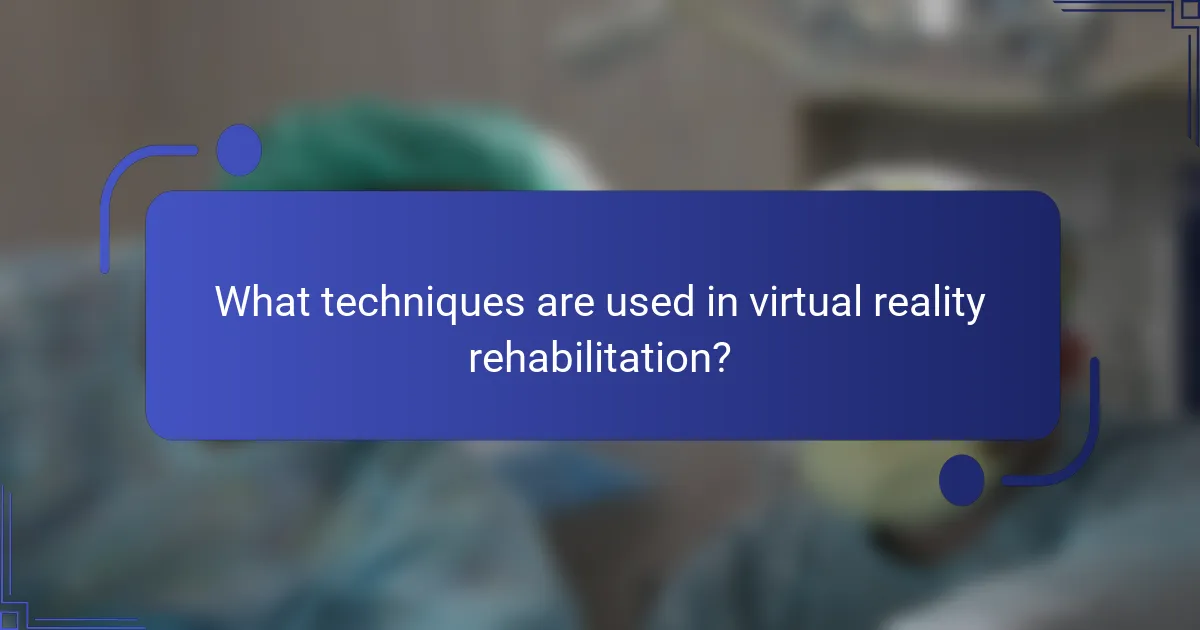
What techniques are used in virtual reality rehabilitation?
Virtual reality rehabilitation employs techniques such as immersive simulations, gamification, and biofeedback. These methods enhance patient engagement and facilitate recovery. Immersive simulations replicate real-world scenarios, allowing patients to practice skills in a safe environment. Gamification motivates users through game-like elements, improving adherence to therapy. Biofeedback provides real-time data on physiological responses, helping patients adjust their efforts. Together, these techniques create a comprehensive approach to rehabilitation, addressing both physical and psychological aspects of recovery.
How does virtual reality enhance physical therapy outcomes?
Virtual reality significantly enhances physical therapy outcomes by providing immersive and engaging environments for rehabilitation. It increases patient motivation and adherence to therapy programs. Virtual reality also allows for tailored exercises, real-time feedback, and safe practice of movements. Studies indicate that patients using virtual reality in therapy experience faster recovery and improved functional outcomes compared to traditional methods.
Which VR platforms are most effective for rehabilitation?
The most effective VR platforms for rehabilitation include Oculus Quest, HTC Vive, and Microsoft HoloLens. These platforms offer immersive environments that enhance patient engagement and recovery.
Oculus Quest provides a user-friendly interface and extensive library of rehabilitation games. HTC Vive offers precise motion tracking, allowing for detailed exercises. Microsoft HoloLens enables mixed-reality experiences that blend physical and virtual elements, supporting diverse rehabilitation techniques.
Research indicates that VR can improve motor skills and reduce pain perception in patients. For example, a study found that patients using VR during physical therapy reported higher satisfaction and motivation.
Overall, these VR platforms are transforming rehabilitation by making therapy more interactive and enjoyable.
What role do gamification and interactivity play in VR rehabilitation?
Gamification and interactivity significantly enhance engagement and motivation in VR rehabilitation. These elements create immersive experiences that encourage patients to participate actively in their recovery. Gamification introduces rewards and challenges, making therapy more enjoyable and less tedious. Interactivity allows patients to manipulate virtual environments, fostering a sense of control and agency. As a result, patients often demonstrate improved adherence to rehabilitation protocols and better overall outcomes.
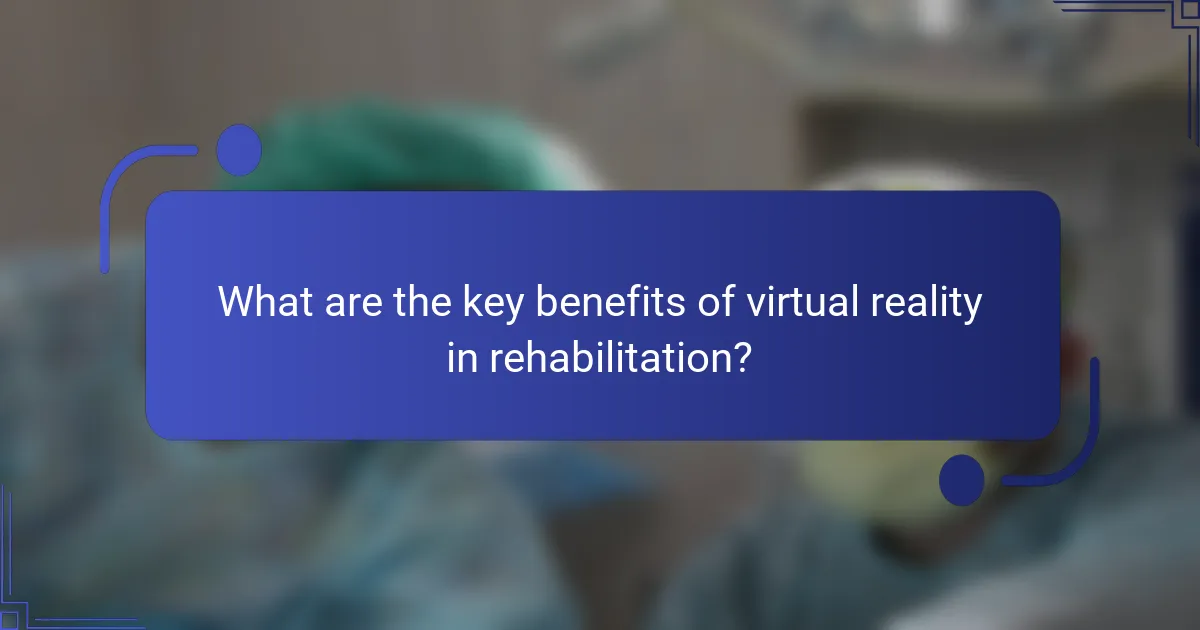
What are the key benefits of virtual reality in rehabilitation?
Virtual reality in rehabilitation offers immersive experiences that enhance patient engagement and recovery outcomes. Key benefits include improved motivation, personalized therapy, enhanced motor skills, and reduced pain perception. Virtual environments allow for tailored exercises that adapt to individual progress, fostering a sense of achievement. Additionally, VR can simulate real-life scenarios, aiding in functional recovery and promoting faster rehabilitation.
How does VR improve patient engagement and motivation?
Virtual reality significantly enhances patient engagement and motivation in rehabilitation by creating immersive experiences. Patients often feel more involved and invested in their recovery process. VR techniques provide interactive scenarios that encourage participation, making therapy sessions enjoyable. As a result, patients are more likely to adhere to their rehabilitation programs. Research indicates that VR can lead to improved outcomes, such as increased range of motion and reduced pain perception, ultimately fostering a positive attitude toward recovery.
What impact does virtual reality have on recovery time?
Virtual reality can significantly reduce recovery time by enhancing patient engagement and facilitating more effective rehabilitation exercises. Studies show that VR applications can improve motor skills and cognitive functions, leading to faster rehabilitation outcomes. For example, patients using VR in physical therapy often experience a 30% reduction in recovery time compared to traditional methods. This technology provides immersive experiences that motivate patients to participate actively in their recovery, thus accelerating the healing process.
Which psychological benefits can be gained from VR rehabilitation?
Virtual reality rehabilitation offers significant psychological benefits, including reduced anxiety, enhanced motivation, and improved mood. These effects stem from immersive experiences that promote engagement and a sense of control. Patients often report increased confidence in their abilities, which can lead to better recovery outcomes. Additionally, VR environments can provide safe spaces for exposure therapy, helping individuals confront fears and phobias in a controlled manner.
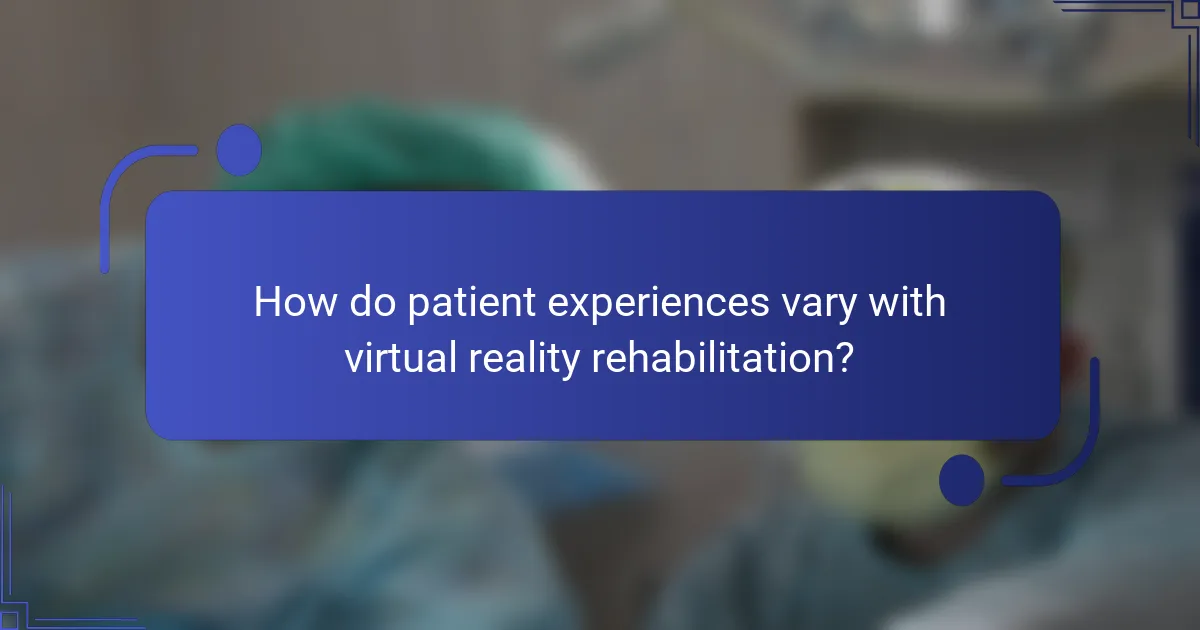
How do patient experiences vary with virtual reality rehabilitation?
Patient experiences with virtual reality rehabilitation vary significantly based on individual needs and treatment goals. Many report enhanced motivation and engagement during sessions, leading to better adherence to rehabilitation programs.
The immersive nature of virtual reality can reduce anxiety and pain perception, making therapy more enjoyable. Patients often experience a sense of control and accomplishment as they navigate virtual environments tailored to their rehabilitation objectives.
Moreover, feedback from studies indicates that some patients show improved physical outcomes, such as increased range of motion and strength, compared to traditional rehabilitation methods. However, experiences can differ based on factors like the type of injury, age, and familiarity with technology.
Overall, virtual reality rehabilitation offers a unique and adaptable approach that can lead to positive patient experiences and outcomes.
What feedback do patients provide on VR rehabilitation techniques?
Patients generally provide positive feedback on VR rehabilitation techniques, highlighting increased engagement and motivation. Many report improved physical outcomes and enhanced cognitive skills. The immersive nature of VR often leads to a more enjoyable experience compared to traditional rehabilitation methods. Additionally, patients appreciate the personalized approach that VR can offer, allowing for tailored exercises that meet individual needs. Some feedback also emphasizes the potential for reduced anxiety during rehabilitation sessions, as VR can create a more controlled and comfortable environment.
How do demographics influence patient experiences in VR rehabilitation?
Demographics significantly influence patient experiences in VR rehabilitation by affecting engagement and outcomes. Factors such as age, socioeconomic status, and cultural background shape how patients interact with technology. For example, younger patients may adapt more quickly to VR environments, while older patients might require more support. Additionally, cultural perceptions of rehabilitation can impact motivation and adherence to treatment plans. Understanding these demographic influences allows for tailored VR rehabilitation programs that enhance patient satisfaction and effectiveness.
What are common challenges faced by patients using VR in rehabilitation?
Patients using VR in rehabilitation commonly face challenges such as motion sickness, technology accessibility, and lack of personalized experiences. Motion sickness can occur due to discrepancies between visual input and physical movement. Accessibility issues may arise from the need for specialized equipment or space. Additionally, some patients may find VR experiences too generic, limiting their effectiveness in addressing individual rehabilitation needs.
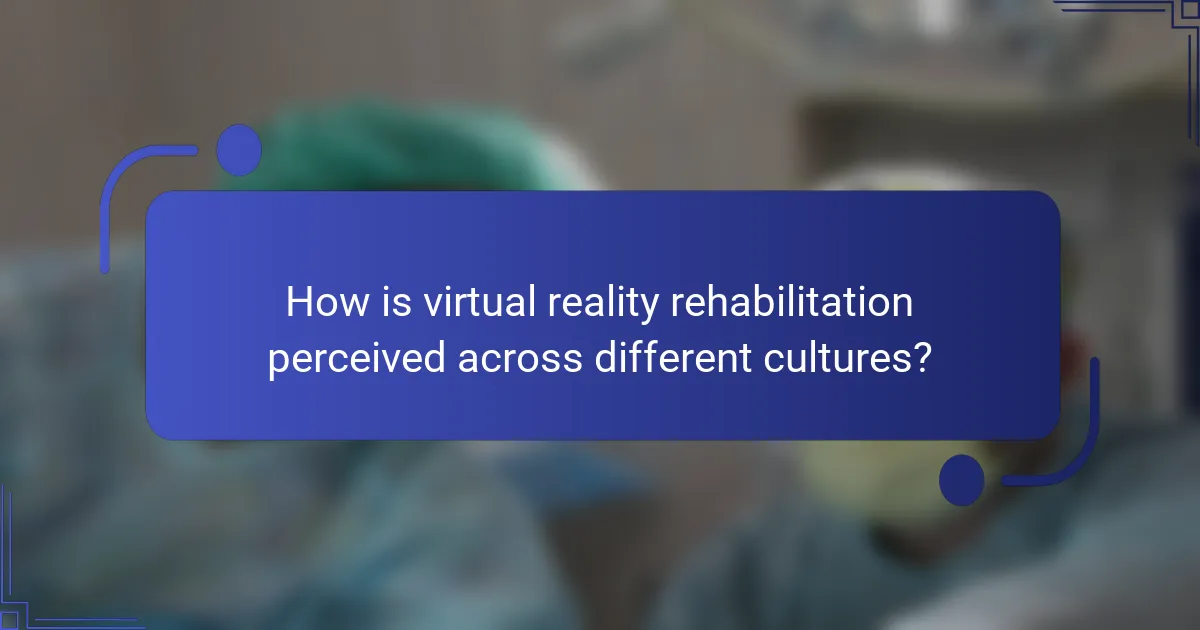
How is virtual reality rehabilitation perceived across different cultures?
Virtual reality rehabilitation is perceived differently across cultures, influenced by technological access, healthcare beliefs, and societal attitudes. In cultures with advanced healthcare systems, VR is often embraced for its innovative approach and effectiveness in physical and cognitive rehabilitation. Conversely, in regions with limited access to technology, VR may be viewed skeptically or as a luxury. Cultural attitudes toward mental health also play a significant role; societies that prioritize holistic health may integrate VR as part of a broader therapeutic approach, while others may focus on traditional methods. Overall, perceptions of VR rehabilitation vary widely, reflecting each culture’s unique values and healthcare infrastructure.
What unique attributes of VR rehabilitation are noted in specific regions?
Unique attributes of VR rehabilitation vary by region, influenced by technological access and cultural acceptance. In North America, immersive simulations enhance physical therapy outcomes. European countries often integrate VR with cognitive rehabilitation, addressing mental health alongside physical recovery. In Asia, VR applications focus on stroke rehabilitation, utilizing gamification to motivate patients. Each region’s unique approach reflects its healthcare priorities and innovation levels.
How do cultural attitudes towards technology affect rehabilitation outcomes?
Cultural attitudes towards technology significantly influence rehabilitation outcomes. Positive perceptions can enhance patient engagement and motivation. In contrast, skepticism may hinder the acceptance of virtual reality rehabilitation methods. For instance, cultures that embrace innovation often see better adherence to VR therapies, leading to improved recovery rates. Additionally, demographic factors like age and technological familiarity play a role in shaping these attitudes. Understanding these cultural dynamics is essential for tailoring rehabilitation programs effectively.
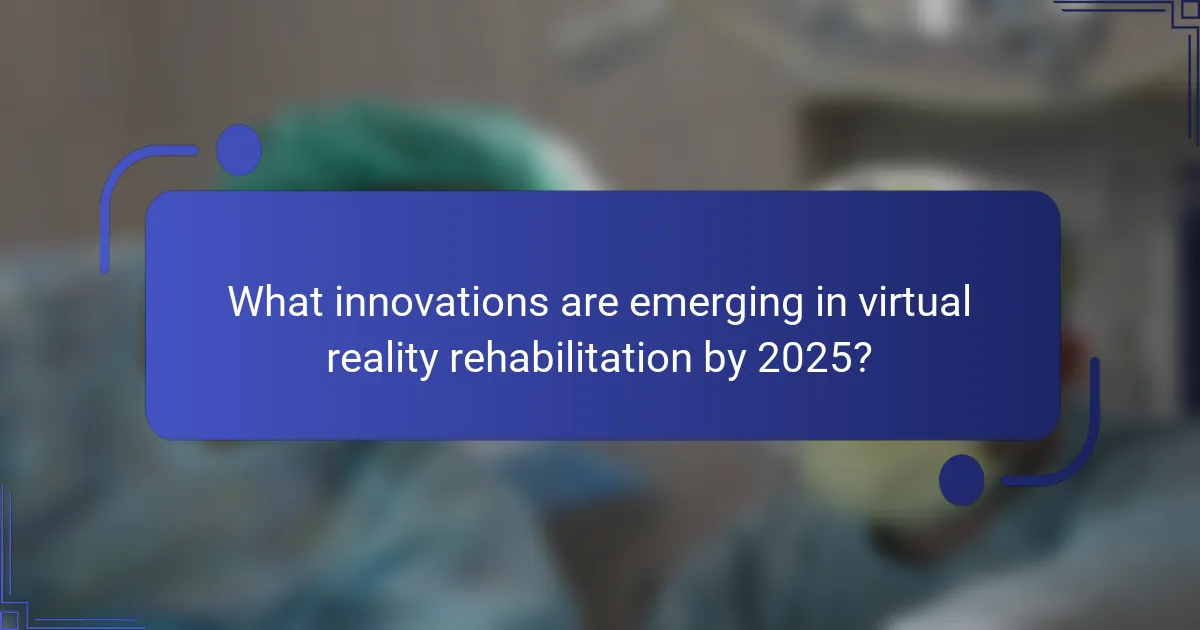
What innovations are emerging in virtual reality rehabilitation by 2025?
Innovations in virtual reality rehabilitation by 2025 will focus on personalized experiences, advanced tracking technologies, and enhanced therapeutic environments. These developments will improve patient engagement and outcomes. For example, adaptive VR systems will tailor exercises to individual progress, while real-time feedback will optimize rehabilitation strategies. Additionally, social VR platforms will foster community support, enhancing motivation and recovery.
Which new technologies are being integrated into VR rehabilitation?
Innovative technologies enhancing VR rehabilitation include motion tracking, haptic feedback, and AI-driven analytics. These advancements improve patient engagement and outcomes. Motion tracking allows precise monitoring of movements, while haptic feedback provides realistic sensations, enhancing the immersive experience. AI analytics personalize therapy by adapting to individual progress.
What future trends are shaping the landscape of VR in rehabilitation?
Emerging technologies are driving future trends in virtual reality for rehabilitation. Key trends include enhanced realism through advanced graphics, increased accessibility via mobile VR platforms, and personalized therapy programs using AI. These innovations improve patient engagement and outcomes, making VR a vital tool in rehabilitation.
What best practices should be considered for effective VR rehabilitation?
Effective VR rehabilitation requires a focus on user engagement, personalized experiences, and consistent feedback. Incorporating gamification can enhance motivation, while regular assessments ensure progress tracking. Multidisciplinary collaboration among therapists, technologists, and patients fosters a holistic approach, addressing diverse rehabilitation needs. Additionally, ensuring accessibility and comfort in VR environments is crucial for patient satisfaction and effectiveness.


